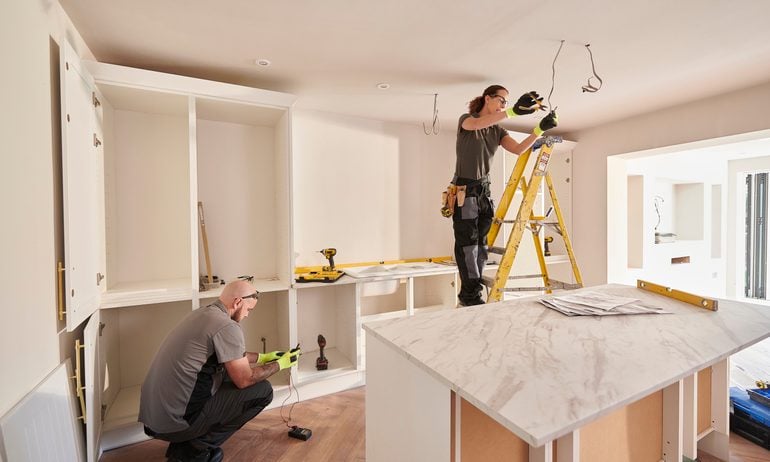Home Equity Loan and HELOC Requirements in 2024
Home equity loans and home equity lines of credit, or HELOCs, are two ways to turn some of your equity into cash.

Some or all of the mortgage lenders featured on our site are advertising partners of NerdWallet, but this does not influence our evaluations, lender star ratings or the order in which lenders are listed on the page. Our opinions are our own. Here is a list of our partners.
As you make mortgage payments and your home value increases, your share of ownership in your home — your equity — also increases. Home equity loans and home equity lines of credit, or HELOCs, are two ways to turn some of that equity into cash without having to sell your home.
What are home equity loans and HELOCs?
A home equity loan converts some of your equity into cash. You’ll receive it as one lump sum and pay it back at a fixed rate.
Alternatively, a HELOC is a line of credit that you can draw on, pay back and draw on again — also called revolving credit — for a set period of time (usually 10 years). It often starts with an adjustable interest rate.
Features of the loan | HELOC | Home equity loan |
|---|---|---|
Loan funding | You can draw funds as needed, up to a certain limit (typically a percentage of your equity). | You receive a lump sum at closing (typically a percentage of your equity). |
Terms | Begins with a draw period (typically 10 years) with interest-only minimum payments. This is followed by a repayment period (often up to 20 years) that requires you to pay back principal and interest. | Repayment periods are often up to 30 years. Minimum payments include both interest and principal. |
Rates | Variable, (though some lenders offer a fixed-rate option) | Fixed |
Borrowing limits | You can typically borrow between 80%-85% of the equity in your home. Some lenders allow for more. Use NerdWallet's HELOC calculator for personalized details. | You can typically borrow between 80%-85% of the equity in your home. Some lenders allow for more. Use NerdWallet’s home equity loan calculator for personalized details. |
Lenders |

What is required to be approved for a HELOC or home equity loan?
HELOCs and home equity loans tend to have the same minimum requirements, although the exact criteria will vary by lender.
Equity of at least 15% to 20%
When the value of your home is greater than what you owe on the mortgage, you’ve got equity. Lenders will want you to have built up at least 15% (preferably 20% or higher) equity in your home, which is often determined by an appraisal.
In order to calculate your equity, simply subtract the mortgage balance (which represents the lender’s ownership stake in the home) from the home’s present value. For example, if your home is worth $250,000 and your remaining mortgage balance is $200,000, you have $50,000 (20%) of available equity in your home. The remaining 80% is inaccessible to you because it’s owned by the lender.
A debt-to-income ratio below 50%
Lenders will want you to have a debt-to-income ratio of 43% to 50% at most, although some will require this to be even lower.
To find your debt-to-income ratio, add up all your monthly debt payments and other financial obligations, including your mortgage, loans and leases, as well as any child support or alimony. Then divide this by your monthly income, and convert that number to a percentage. For example, your DTI is 40% if you earn $3,000 a month and make payments totaling $1,200.
A credit score over 620
Borrowers will typically need to have a credit score of at least 620 to qualify for a home equity loan or HELOC. The higher your credit score, the stronger your application will be.
According to the credit reporting company Experian, borrowers have the best chance of qualifying for approval with a score of at least 700. If your score is lower, you should be an exceptional candidate in other areas.
» MORE: How to improve your credit fast
A strong history of paying bills on time
A strong track record of paying your bills on time demonstrates your reliability as a borrower. Late payments stay on your credit report for seven years, and the longer a bill goes past due, the stronger its impact on your financial profile.
Home equity loan and HELOC rates
Most home equity loan and HELOC interest rates are indexed to a base rate called the prime rate. This is the lowest possible rate that lenders are able to offer their most attractive borrowers. Lenders will add a margin to this prime rate in order to calculate your rate offer.
This margin will vary from borrower to borrower based on factors like your credit score, your existing debt and the amount you wish to borrow.
Current prime rate | Prime rate last week | Prime rate in the past year — low | Prime rate in the past year — high |
|---|---|---|---|
7.5% | 7.5% | 7.5% | 8.5% |
Shopping around with multiple lenders allows you to compare rate offers and find the most cost effective option.
Who should get a home equity loan
Since borrowers receive home equity loans as one lump sum, this is an ideal way to tap your equity if you know exactly how much you’ll need to borrow. This kind of loan can also be a good fit if you’re financing just one project or other expense, so long as you meet the lender’s minimum criteria.
Who should get a HELOC
Since HELOCs are a line of credit that you can draw from as needed, they’re a more flexible option for tapping your equity. If you know that you’ll want to make ongoing withdrawals — such as for a series of projects — or if you don’t yet know exactly how much you’ll need to finance your expenses, then a HELOC could be a good fit for your needs.
All second mortgages come with some risk: When you borrow against your home’s equity, you’re putting your house on the line as collateral, which means you could lose your home to foreclosure if you don't make payments on time. Borrowers should be confident that they can afford the extra payments before taking out these loans.


